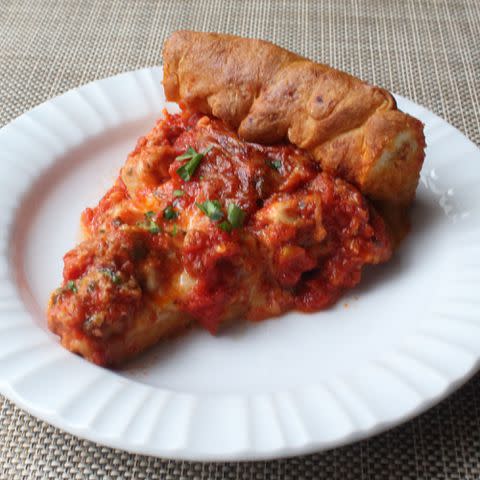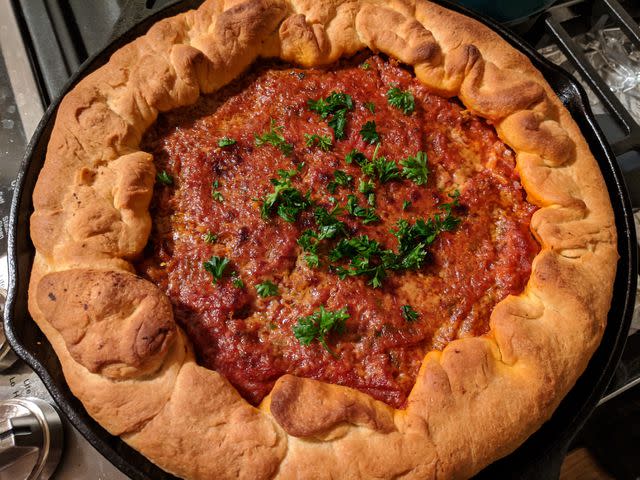What Is Chicago-Style Pizza—And How Do You Make It At Home?
Here's what you need to know.

Robert Mariani/Getty Images
Chicagoans have many local dishes to be proud of, but their pizza might be the most iconic. Chicago-style pizza usually refers to deep-dish pizza—a pizza that looks and tastes very different from just about any other you’ll find. Ahead, learn what makes it so unique and how to recreate it at home.
What is Chicago-Style Pizza?
Chicago-style pizza is a style of pizza that originated in Chicago. It usually refers to deep-dish pizza. Thin-crust pizza lovers or those who prefer a spare hand with toppings might not love this style of pizza, though there are many styles to choose from. When it comes to this type of pizza, more is always more.

Is Chicago-Style Pizza Deep Dish?
Deep dish is one style of Chicago pizza, and perhaps the one it’s most famous for. Locals also love what’s called tavern-style pizza, a very thin, crispy crust that’s traditionally cut into squares. Stuffed crust deep dish pizza is also native to Chicago.
Chicago-Style Pizza Defining Characteristics
What sets Chicago-style pizza apart from any other pie? Here’s the blueprint:
Extra-high crust: This allows lots of room for extra sauce, cheese, and toppings. The dough for the crust often includes semolina or cornmeal, giving it a yellow tint.
Extra-crispy crust: Because it bakes in a high-sided metal pan for a long time (to account for all that filling!), this crust gets nicely crisp on the outside. This is similar to the equally delicious Detroit-style pizza.
Order of toppings: Instead of the cheese going on last, this pizza starts with a thick layer of cheese on the bottom. This is followed by generous layers of toppings and a top layer of sauce. Yes, the sauce goes on the very top—what helps protect the pizza from drying out or burning during its much longer cook time.
Thicker sauce: The tomato sauce is different from your typical pie, being both thicker and chunkier.
Knife-and-fork slice: You can’t pick up this hefty pizza wedge with your hands like other pizzas. You’ll definitely need a knife and a fork.
This History of Chicago-Style Pizza
Chicago deep-dish pizza was born at Pizzeria Uno, a local restaurant, in 1943. Founder Ike Sewell, chef Rudy Malnati, and then cook Alice Raymond have each gotten credit for the pie’s invention. Sewell and his co-founder, Ric Ricardo, opened a second location of the restaurant nearby called Pizzeria Due in 1955, which was also well-known for the pie. As its popularity grew, restaurants all over the city began to make the dish their own. You can visit Pizzeria Uno, Pizzeria Due, Giardano’s, Lou Malnati’s, or Pizano’s for an authentic slice.

Stuffed Pizza vs. Deep Dish Pizza
Stuffed pizza is a variation on Chicago-style deep-dish pizza. In this pie, a layer of crust is topped with a generous layer of cheese, then another layer of crust, before meat, veggies, and tomato sauce are added. This version dates back to 1971, when Nancy and Rocco Palese introduced it at their restaurant, Nancy’s Pizzeria.
How to Make Chicago-Style Pizza
Ready to make your own Chicago-style deep-dish pizza at home? Get started with our top-rated recipe. You’ll find the ingredient list and step-by-step instructions there. Here’s what you can expect:
Prepare the crust: This recipe saves time by using thawed frozen bread dough. Press this into the bottom and up the sides of a baking dish to get the characteristic deep dish.
Cook the filling: Brown the sausage in a skillet. You can also use any other meat or veggies here.
Layer toppings in the crust: Add meats to the crust in a single layer, then top with a layer of cheese, then another layer of toppings like vegetables or other meats. Finish with more cheese. If you like, you can add a top layer of jarred marinara sauce.
Bake the pizza: Instead of a scorchingly high heat for a short period of time, bake this pizza at a low, even heat for about 30 minutes.
Read the original article on All Recipes.


